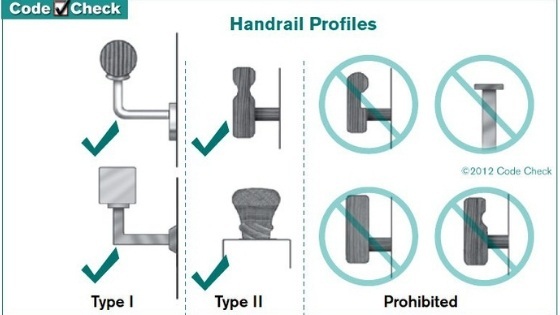It’s hard for most people to go a day without encountering a flight of stairs and a handrail but most of us are unware of all the energy that goes into designing them. Over the years handrails have evolved greatly in the name of safety and as a result of accidents that have occurred from people using stairs.
Most of us don’t always need a handrail but if/when we do, it’s good to have a correct one to grab onto. Modern handrails have very specific design criteria that must be in place to meet the current building code. Here are a couple of the most important safety aspects that should be present with the handrails in your house:
A graspable surface – You’ll notice that things in the world that you are supposed to grab onto have similar characteristics – they are generally rounded and sized to fit easily into your hand. The shift lever in your car, a golf club, door knobs and shopping cart handles are all made so your fingers curl around them and can hold on quickly and easily. Handrails in houses are designed with the same idea in mind. A proper railing should have a graspable surface sized so a person can quickly grab on if they are falling. The way I like to explain this to people is to imagine your grandmother using the stairs. If she were to lose her footing and start to fall, having something that is easy to grab onto could make the difference between her staying up and falling down the stairs. A very common mistake I see even very experienced contractors make is to just use a flat 2X4 as a handrail. A 2X4 is a rectangle that is far too large for a person to fit their hand around and is not at all easy to grab onto in a hurry. Virtually every lumber supply house and home supply store sells stock that is specifically intended for use as a handrail. Be sure you (or your contractor) get the right material for the job.
A handrail with a return – Most people probably don’t understand what this technical description is but essentially a “return” just means that a handrail should not be open on the ends. It should “return” to the wall. For years handrails were open on the ends but it was found that a lot of injuries occurred from people catching loose clothing on the open ends of railings and falling on the stairs. An open ended handrail is a lot like a coat hook and as a person is walking up or down stairs it is very easy for a pocket of a loose jacket to be caught. Think again of your grandmother and how easy it would be for her to be knocked off balance and fall if her clothing were to suddenly be caught. So, along with using the correct graspable material for a handrail be sure it is installed properly and terminates or “returns” to the wall or other surface.

